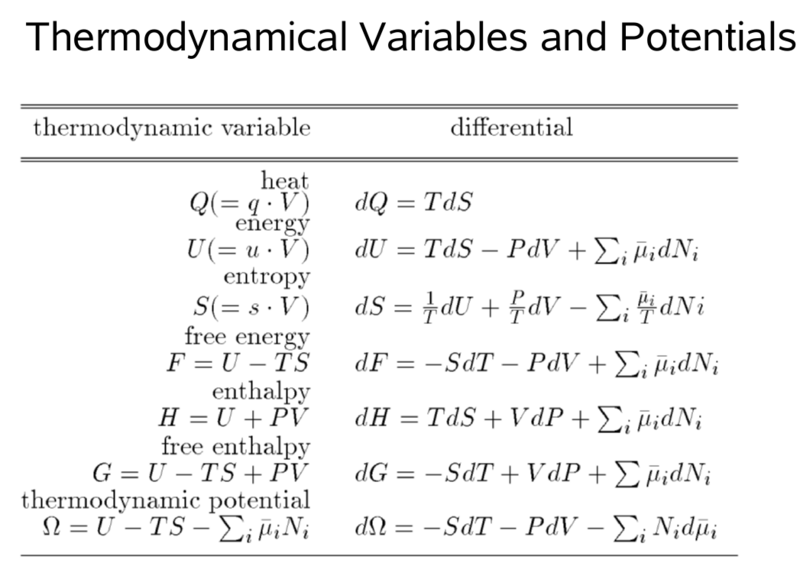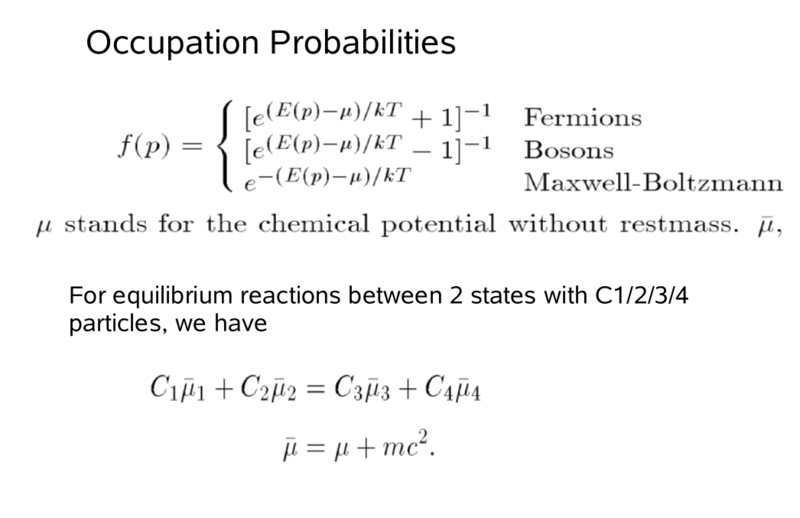2nd Week: Properties of Astrophysical Plasmas C: Difference between revisions
Carpino John (talk | contribs) No edit summary |
No edit summary |
||
| Line 1: | Line 1: | ||
==Thermodynamic Quantities== | |||
Important thermodynamic quantities for a volume <math>V</math> can be found by integrating over the product of the density of state function <math>\omega(p)</math> and the occupation probability of each state <math>f(p)</math> for all momenta. So for example, the number density is: | |||
[[Image:Occupation Probabilities.png]] | <math> n=\frac{N}{V}=\int{\omega(p)f(p)dp}</math> | ||
and the energy density is: | |||
<math> e=\frac{E}{V}=\int{E(p)\omega(p)f(p)dp}</math> | |||
and pressure is: | |||
<math> P=\int{pv\omega(p)f(p)dp}</math> | |||
So for example, to find <math>\omega(p)</math> for a particle in a box, we can start with the well known solution for such a particles energy levels: | |||
<math>E=\frac{\pi^2\hbar^2}{2md^2}(n_x^2+n_y^2+n_z^2)</math> | |||
Then we want the number of states that lead to a particle having an energy of E or less. Take the three n quantum numbers as a vectors within a sphere with radius, then for large energies the number of possible values that these n's can take to give that energy or less is just the area of the sphere <math> 4/3\pi R^3 </math>. Of course, we don't know what to do with negative values of n, so we'll just take the 1/8th of the sphere for which all values are positive. This gives us, for number of states: | |||
<math>n_{states}=\frac{4g\pi}{3\hbar^3}(2mE)^{3/2}</math> | |||
And our density of states is just the number per, dE, so taking the derivative with respect to E: | |||
<math>\omega=\frac{2\pi g}{\hbar^3}(2m)^{3/2}E^{1/2}</math> | |||
[[Image:Thermodynamical Variables and Potentials.png|800px]] | |||
[[Image:Occupation Probabilities.png|800px]] | |||
Revision as of 12:19, 30 January 2009
Thermodynamic Quantities
Important thermodynamic quantities for a volume can be found by integrating over the product of the density of state function and the occupation probability of each state for all momenta. So for example, the number density is:
and the energy density is:
and pressure is:
So for example, to find for a particle in a box, we can start with the well known solution for such a particles energy levels:
Failed to parse (SVG (MathML can be enabled via browser plugin): Invalid response ("Math extension cannot connect to Restbase.") from server "https://wikimedia.org/api/rest_v1/":): {\displaystyle E=\frac{\pi^2\hbar^2}{2md^2}(n_x^2+n_y^2+n_z^2)}
Then we want the number of states that lead to a particle having an energy of E or less. Take the three n quantum numbers as a vectors within a sphere with radius, then for large energies the number of possible values that these n's can take to give that energy or less is just the area of the sphere Failed to parse (SVG (MathML can be enabled via browser plugin): Invalid response ("Math extension cannot connect to Restbase.") from server "https://wikimedia.org/api/rest_v1/":): {\displaystyle 4/3\pi R^3 } . Of course, we don't know what to do with negative values of n, so we'll just take the 1/8th of the sphere for which all values are positive. This gives us, for number of states:
Failed to parse (SVG (MathML can be enabled via browser plugin): Invalid response ("Math extension cannot connect to Restbase.") from server "https://wikimedia.org/api/rest_v1/":): {\displaystyle n_{states}=\frac{4g\pi}{3\hbar^3}(2mE)^{3/2}}
And our density of states is just the number per, dE, so taking the derivative with respect to E:
Failed to parse (SVG (MathML can be enabled via browser plugin): Invalid response ("Math extension cannot connect to Restbase.") from server "https://wikimedia.org/api/rest_v1/":): {\displaystyle \omega=\frac{2\pi g}{\hbar^3}(2m)^{3/2}E^{1/2}}







